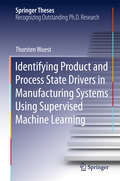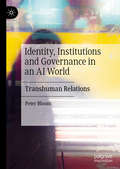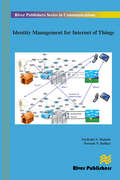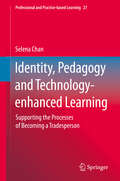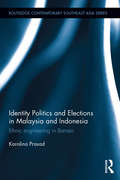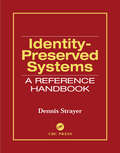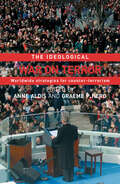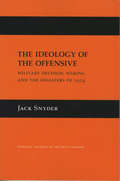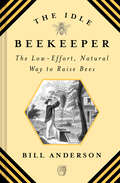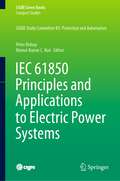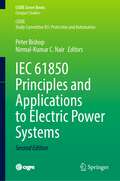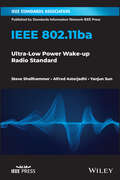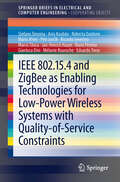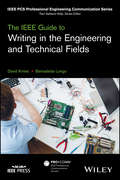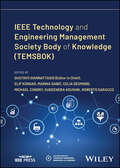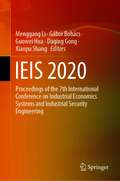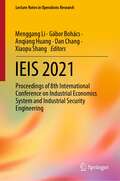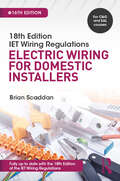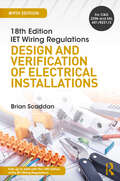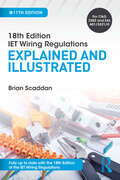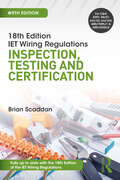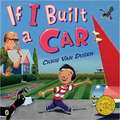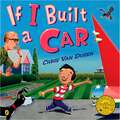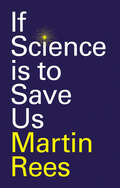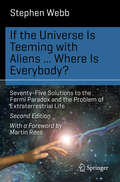- Table View
- List View
Identifying Product and Process State Drivers in Manufacturing Systems Using Supervised Machine Learning
by Thorsten WuestThe book reports on a novel approach for holistically identifying the relevant state drivers of complex, multi-stage manufacturing systems. This approach is able to utilize complex, diverse and high-dimensional data sets, which often occur in manufacturing applications, and to integrate the important process intra- and interrelations. The approach has been evaluated using three scenarios from different manufacturing domains (aviation, chemical and semiconductor). The results, which are reported in detail in this book, confirmed that it is possible to incorporate implicit process intra- and interrelations on both a process and programme level by applying SVM-based feature ranking. In practice, this method can be used to identify the most important process parameters and state characteristics, the so-called state drivers, of a manufacturing system. Given the increasing availability of data and information, this selection support can be directly utilized in, e. g. , quality monitoring and advanced process control. Importantly, the method is neither limited to specific products, manufacturing processes or systems, nor by specific quality concepts.
Identity, Institutions and Governance in an AI World: Transhuman Relations
by Peter BloomThe 21st century is on the verge of a possible total economic and political revolution. Technological advances in robotics, computing and digital communications have the potential to completely transform how people live and work. Even more radically, humans will soon be interacting with artificial intelligence (A.I.) as a normal and essential part of their daily existence. What is needed now more than ever is to rethink social relations to meet the challenges of this soon-to-arrive "smart" world. This book proposes an original theory of trans-human relations for this coming future. Drawing on insights from organisational studies, critical theory, psychology and futurism - it will chart for readers the coming changes to identity, institutions and governance in a world populated by intelligent human and non-human actors alike. It will be characterised by a fresh emphasis on infusing programming with values of social justice, protecting the rights and views of all forms of "consciousness" and creating the structures and practices necessary for encouraging a culture of "mutual intelligent design". To do so means moving beyond our anthropocentric worldview of today and expanding our assumptions about the state of tomorrow's politics, institutions, laws and even everyday existence. Critically such a profound shift demands transcending humanist paradigms of a world created for and by humans and instead opening ourselves to a new reality where non-human intelligence and cyborgs are increasingly central.
Identity Management for Internet of Things (River Publishers Series In Communications Ser.)
by Parikshit N. Mahalle Poonam N. RailkarThe Internet of Things is a wide-reaching network of devices, and these devices can intercommunicate and collaborate with each other to produce variety of services at any time, any place, and in any way. Maintaining access control, authentication and managing the identity of devices while they interact with other devices, services and people is an important challenge for identity management. The identity management presents significant challenges in the current Internet communication. These challenges are exacerbated in the internet of things by the unbound number of devices and expected limitations in constrained resources. Current identity management solutions are mainly concerned with identities that are used by end users, and services to identify themselves in the networked world. However, these identity management solutions are designed by considering that significant resources are available and applicability of these identity management solutions to the resource constrained internet of things needs a thorough analysis. Technical topics discussed in the book include:• Internet of Things;• Identity Management;• Identity models in Internet of Things;• Identity management and trust in the Internet of Things context;• Authentication and access control;Identitymanagement for Internet of Things contributes to the area of identity management for ubiquitous devices in the Internet of Things. It initially presents the motivational factors together with the identity management problems in the context of Internet of Things and proposes an identity management framework. Following this, it refers to the major challenges for Identitymanagement and presents different identity management models. This book also presents relationship between identity and trust, different approaches for trust management, authentication and access control.
Identity, Pedagogy and Technology-enhanced Learning: Supporting the Processes of Becoming a Tradesperson (Professional and Practice-based Learning #27)
by Selena ChanThis book gathers work from over a decade of study, and seeks to better understand and support how learners become tradespeople. The research programme applies recent concepts from neuroscience, educational psychology and technology-enhanced learning to explain and help overcome the challenges of learning in trades-learning contexts. Due to the complex and multifarious nature of the work characterising trade occupations, learning how to become a tradesperson requires a significant commitment in terms of time, along with physical and cognitive effort. All modalities (visual, aural, haptic etc.) and literacies (text, numerical, spatial etc.) are required when undertaking trade work. Manual dexterity and strength, coupled with the technical and tacit knowledge required for complex problem solving, not to mention suitable dispositional approaches, must all be learnt and focused on becoming a tradesperson.However, there is a substantial gap in the literature on 'how people learn a trade' and 'how to teach a trade'. In this book, contemporary teaching and learning approaches and strategies, as derived through practice-based participatory research, are used to highlight and discuss pragmatic solutions to facilitate the learning and teaching of trade skills, knowledge and dispositions. The approaches and strategies discussed include the implementation of technology-enhanced learning; project-based inquiry/problem-based learning; and recommendations to ensure learners are prepared for the future of work.
Identity Politics and Elections in Malaysia and Indonesia: Ethnic Engineering in Borneo (Routledge Contemporary Southeast Asia Series)
by Karolina PrasadIn recent social research, ethnicity has mostly been used as an explanatory variable. It was only after it was agreed that ethnicity, in itself, is subject to change, were the questions of how and why it changes, possible to answer. This multiplicity of ethnic identities requires that we think of each society as one with multiple ethnic dimensions, of which any can become activated in the process of political competition - and sometimes several of them within a short period of time. Focusing on Malaysia and Indonesia, this book traces the variations of ethnic identity by looking at electoral strategies in two sub-national units. It shows that ethnic identities are subject to change - induced by calculated moves by political entrepreneurs who use identities as tools to maximize their chances of winning elections or expanding support base - and highlights how political institutions play an enormous role in shaping the modes and dynamics of these ethno-political manipulations. The book suggests that in societies where ethnic identities are activated in politics, instead of analysing politics with ethnic distribution as an independent variable, ethnic distribution can be taken as the dependent variable, with political institutions being the explanatory one. It examines the problems of voters’ behaviour, and parties’ and candidates’ strategy in a polity that is, to a significant extent, driven by ethnic relations. Pushing the boundaries of qualitative research on Southeast Asian politics by placing formal institutions at the centre of its analysis, this book will be of interest to students and scholars of Southeast Asian Politics, Race and Ethnic Studies, and International Relations.
Identity-Preserved Systems: A Reference Handbook
by Dennis StrayerIdentity-Preserved Systems: A Reference Handbook provides background for the development of processes or systems of maintaining the segregation of and documenting the identity of a product. Growers and other parties that handle, transport, condition, or process the identity-preserved (IP) product must follow strict growing and handling practices, i
The Ideological War on Terror: Worldwide Strategies For Counter-Terrorism (Political Violence)
by Graeme P. Herd Anne AldisThis edited book addresses the appropriateness of US and other counter-terrorist (CT) strategies in Europe and Eurasia, the Middle East, the Asia Pacific region and in Latin America, with a view to improving their effectiveness. The book has three main objectives: to re-examine terrorists' strategic goals and sources of legitimacy and the nature of their ideological support to analyze current US and regional CT strategies and assess their success in de-legitimizing terrorists and undermining their support to provide a strategic synthesis and policy recommendations in light of the research findings. This book will be of interest to students of political violence and terrorism, security studies and international relations in general.
The Ideology of the Offensive
by Jack SnyderJack Snyders analysis of the attitudes of military planners in the years prior to the Great War offers new insight into the tragic miscalculations of that era and into their possible parallels in present-day war planning. By 1914, the European military powers had adopted offensive military strategies even though there was considerable evidence to support the notion that much greater advantage lay with defensive strategies. The author argues that organizational biases inherent in military strategists attitudes make war more likely by encouraging offensive postures even when the motive is self-defense. Drawing on new historical evidence of the specific circumstances surrounding French, German, and Russian strategic policy, Snyder demonstrates that it is not only rational analysis that determines strategic doctrine, but also the attitudes of military planners. Snyder argues that the use of rational calculation often falls victim to the pursuit of organizational interests such as autonomy, prestige, growth, and wealth. Furthermore, efforts to justify the preferred policy bring biases into strategists decisions biases reflecting the influences of parochial interests and preconceptions, and those resulting from attempts to simplify unduly their analytical tasks. The frightening lesson here is that doctrines can be destabilizing even when weapons are not, because doctrine may be more responsive to the organizational needs of the military than to the implications of the prevailing weapons technology. By examining the historical failure of offensive doctrine, Jack Snyder makes a valuable contribution to the literature on the causes of war.
The Idle Beekeeper: The Low-Effort, Natural Way to Raise Bees
by Bill AndersonFrom building a hive to harvesting honey, a top urban beekeeper shares how to care for bees the simple, mindful way. Global bee populations have been rapidly declining for years, and it’s not just our honey supply that’s at stake: the contribution of bees to the pollination of crops is essential to human survival. But even in industrial apiaries, bees are in distress, hiving in synthetic and hostile environments. Enter idle beekeeping: the grassroots, low-intervention system that seeks to emulate the behavior and habitat of bees in the wild—and it only requires two active days of beekeeping per year, one in the spring and another in the fall. In The Idle Beekeeper, Bill Anderson calls upon his years of applied curiosity as an urban beekeeper to celebrate these underappreciated insects and show how simple and rewarding beekeeping can be. In this entertaining, philosophical, and practical guide, Anderson shares why and how to build a hive system that is both cutting-edge and radically old. Maximum idleness is achieved through step-by-step directions to help the beekeeper gently harvest honey with minimum effort, make mead and beeswax candles, and closely observe and understand these fascinating and productive social creatures. For anyone interested in keeping bees, The Idle Beekeeper is the definitive guide to getting started, even in a city, and without effort.
IEC 61850 Principles and Applications to Electric Power Systems (CIGRE Green Books)
by Peter Bishop Nirmal-Kumar C. NairThis book offers a compact guide to IEC61850 systems, including wide-area implementation, as it has been applied to real substations worldwide. It utilises technical brochures and papers based on existing practice of IEC61850 systems that give stakeholders from different disciplines an understanding of systems in use, their features, how they are applied and approach for implementation. The book offers a holistic practical view considering all relevant interfaces and possibilities. It includes the different applications, practical implementation considerations and choices made for IEC61850 PACS (Protection Automation & Control System) designs. Power system engineers, planners, technicians and researchers will find the book useful for exploring, developing and delivering these systems.
IEC 61850 Principles and Applications to Electric Power Systems (CIGRE Green Books)
by Peter Bishop Nirmal-Kumar C. NairThis book offers a compact guide to IEC61850 systems, including wide-area implementation, as it has been applied to real substations worldwide. It utilises technical brochures and papers based on existing practice of IEC61850 systems that give stakeholders from different disciplines an understanding of systems in use, their features, how they are applied, and approach for implementation. The book offers a holistic practical view considering all relevant interfaces and possibilities. It includes the different applications, practical implementation considerations and choices made for IEC61850 PACS (Protection Automation & Control System) designs. Power system engineers, planners, technicians and researchers will find the book useful for exploring, developing and delivering these systems.This second edition of the book includes publication quality corrections. The technical content remains unaltered.
IEEE 802.11ba: Ultra-Low Power Wake-up Radio Standard
by Steve Shellhammer Alfred Asterjadhi Yanjun SunIEEE 802.11ba Discover the latest developments in IEEE 802.11ba and Wake-up Radios In IEEE 802.11ba: Ultra-Low Power Wake-up Radio Standard, expert engineers Drs. Steve Shellhammer, Alfred Asterjadhi, and Yanjun Sun deliver a detailed discussion of the IEEE 802.11ba standard. The book begins by explaining the concept of a wake-up radio (WUR) and how it fits into the overall 802.11 standard, as well as how a WUR saves power and extends battery life. The authors go on to describe the medium access control (MAC) layer in detail and then talk about the various protocols used to negotiate WUR operation, its uses for different functionalities (like wake up of the main radio, discovery, synchronization, and security). The book offers a detailed description of the physical (PHY) layer packet construction and the rationale for the design, as well as the various design aspects of the medium access control layer. It also includes: A thorough introduction to the motivations driving the development of the WUR in 802.11 Practical overviews of IEEE 802.11, including the basic concepts of 802.11 (the PHY and MAC) and background material on current low power modes Comprehensive discussions of the physical layer and PHY layer performance, including the generic receiver, the PPDU, Transmit Diversity, and the FDMA mode In-depth examinations of the medium access layer and its frame designs Perfect for professional wireless engineers, IEEE 802.11ba: Ultra-Low Power Wake-up Radio Standard will also earn a place in the libraries of academics and students researching and studying in fields involving wireless communications.
IEEE 802.15.4 and ZigBee as Enabling Technologies for Low-Power Wireless Systems with Quality-of-Service Constraints
by Petr Jurčík Ricardo Severino Stefano Tennina Roberta Daidone Gianluca Dini Nuno Pereira Marco Tiloca Mélanie Bouroche Anis Koubâa Jan-Hinrich Hauer Mário Alves Eduardo TovarThis book outlines the most important characteristics of IEEE 802.15.4 and ZigBee and how they can be used to engineer Wireless Sensor Network (WSN) systems and applications, with a particular focus on Quality-of-Service (QoS) aspects. It starts by providing a snapshot of the most relevant features of these two protocols, identifying some gaps in the standard specifications. Then it describes several state-of-the-art open-source implementations, models and tools that have been designed by the authors and have been widely used by the international community. The book also outlines the fundamental performance limits of IEEE 802.15.4/ZigBee networks, based on well-sustained analytical, simulation and experimental models, including how to dimension such networks to optimize delay/energy trade-offs.
The IEEE Guide to Writing in the Engineering and Technical Fields
by David Kmiec Bernadette LongoHelps both engineers and students improve their writing skills by learning to analyze target audience, tone, and purpose in order to effectively write technical documents This book introduces students and practicing engineers to all the components of writing in the workplace. It teaches readers how considerations of audience and purpose govern the structure of their documents within particular work settings. The IEEE Guide to Writing in the Engineering and Technical Fields is broken up into two sections: “Writing in Engineering Organizations” and “What Can You Do With Writing?” The first section helps readers approach their writing in a logical and persuasive way as well as analyze their purpose for writing. The second section demonstrates how to distinguish rhetorical situations and the generic forms to inform, train, persuade, and collaborate. The emergence of the global workplace has brought with it an increasingly important role for effective technical communication. Engineers more often need to work in cross-functional teams with people in different disciplines, in different countries, and in different parts of the world. Engineers must know how to communication in a rapidly evolving global environment, as both practitioners of global English and developers of technical documents. Effective communication is critical in these settings. The IEEE Guide to Writing in the Engineering and Technical Fields Addresses the increasing demand for technical writing courses geared toward engineers Allows readers to perfect their writing skills in order to present knowledge and ideas to clients, government, and general public Covers topics most important to the working engineer, and includes sample documents Includes a companion website that offers engineering documents based on real projects The IEEE Guide to Engineering Communication is a handbook developed specifically for engineers and engineering students. Using an argumentation framework, the handbook presents information about forms of engineering communication in a clear and accessible format. This book introduces both forms that are characteristic of the engineering workplace and principles of logic and rhetoric that underlie these forms. As a result, students and practicing engineers can improve their writing in any situation they encounter, because they can use these principles to analyze audience, purpose, tone, and form.
IEEE Technology and Engineering Management Society Body of Knowledge (IEEE Press Series on Technology Management, Innovation, and Leadership)
by Gustavo Giannattasio Elif Kongar Marina Dabić Celia Desmond Michael Condry Sudeendra Koushik Roberto SaraccoIEEE Technology and Engineering Management Society Body of Knowledge (TEMSBOK) IEEE TEMS Board of Directors-approved body of knowledge dedicated to technology and engineering management The IEEE Technology and Engineering Management Society Body of Knowledge (TEMSBOK) establishes a set of common practices for technology and engineering management, acts as a reference for entrepreneurs, establishes a basis for future official certifications, and summarizes the literature on the management field in order to publish reference documentation for new initiatives. The editors have used a template approach with authors that instructed them on how to introduce their manuscript, how to organize the technology and area fundamentals, the managing approach, techniques and benefits, realistic examples that show the application of concepts, recommended best use (focusing on how to identify the most adequate approach to typical cases), with a summary and conclusion of each section, plus a list of references for further study. The book is structured according to the following area knowledge chapters: business analysis, technology adoption, innovation, entrepreneurship, project management, digital disruption, digital transformation of industry, data science and management, and ethics and legal issues. Specific topics covered include: Market requirement analysis, business analysis for governance planning, financial analysis, evaluation and control, and risk analysis of market opportunities Leading and managing working groups, optimizing group creation and evolution, enterprise agile governance, and leading agile organizations and working groups Marketing plans for new products and services, risk analysis and challenges for entrepreneurs, and procurement and collaboration Projects, portfolios and programs, economic constraints and roles, integration management and control of change, and project plan structure The IEEE Technology and Engineering Management Society Body of Knowledge (TEMSBOK) will appeal to engineers, graduates, and professionals who wish to prepare for challenges in initiatives using new technologies, as well as managers who are responsible for conducting business involving technology and engineering.
IEIS 2020: Proceedings of the 7th International Conference on Industrial Economics Systems and Industrial Security Engineering
by Menggang Li Gábor Bohács Guowei Hua Daqing Gong Xiaopu ShangThis book contains selected papers of the International Conference on Industrial Economics Systems and Industrial Security Engineering (IEIS 2020), which is co-organized by Beijing Jiaotong University, Budapest University of Technology and Economics, in July 25–28 2020. This book aims to provide new research methods, theories and applications from various areas of industrial economics and engineering. In detail the included scientific papers analyze and describe communication processes in the fields of industrial economics, industrial system, industrial security and engineering and other related areas. The variety of papers delivers added value for both scholars and practitioners.
IEIS 2021: Proceedings of 8th International Conference on Industrial Economics System and Industrial Security Engineering (Lecture Notes in Operations Research)
by Menggang Li Dan Chang Xiaopu Shang Gábor Bohács Anqiang HuangThis book aims to provide new research methods, theories and applications from various areas of industrial economics and engineering. In detail, the included scientific papers analyse and describe communication processes in the fields of industrial economics, industrial system, industrial security and engineering and other related areas. The variety of the papers delivers added value for both scholars and practitioners. This book is the documentation of the IEIS 2021 conference. The book covers a great deal of research achievements in industrial restructuring strategy, industrial organization, industrial policy, departmental economic research, industrial competitiveness, regional industrial structure, national industrial economic security theory and empirical research, and it emphasizes on combining theory with practice. The book aims to discuss the issues in industrial economics and industrial security theories and practices. It is the documentation of IEIS 2021 conference, which took place at Shandong University. Due to the impact of COVID-19, it took place online as a virtual conference.
IET Wiring Regulations: Electric Wiring for Domestic Installers, 16th ed
by Brian ScaddanThis book is essential reading for anyone studying towards Domestic Installer status with an approval body such as NICEIC, NAPIT or ELECSA, in line with Part P of the Building Regulations, and also serves as a handy pocket guide to best practice for electricians. Although not intended as a DIY manual, non-qualified persons will also find it useful reading. The how-to guide for home wiring to professional standards. Now with more on LED lighting. Essential reading for serious DIY, electrical installation, basic plumbing, heating systems, TV and security alarm installation. Up to date with the 18th Edition of the IET Wiring Regulations.
IET Wiring Regulations: Design And Verification Of Electrical Installations
by Brian ScaddanThis popular guide provides an understanding of basic design criteria and calculations, along with current inspection and testing requirements and explains how to meet the requirements of the IET Wiring Regulations. The book explains in clear language those parts of the regulations that most need simplifying. There are common misconceptions regarding bonding, voltages, disconnection times and sizes of earthing conductors. This book clarifies the requirements and outlines the correct procedures to follow. This provides an affordable reference for all electrical contractors, technicians and other workers involved in designing and testing electrical installations. The content covers the requirements for both City & Guilds and EAL courses, and contains sample exam questions and answers. It also makes an ideal revision guide. Fully up to date with the 18th Edition of IET Wiring Regulations. Simplifies the advice found in the Wiring Regulations, explaining what they mean in actual working practice for design and testing. Expert advice from an engineering training consultant, supported with colour diagrams, examples and key data.
IET Wiring Regulations: Explained and Illustrated, 11th ed
by Brian ScaddanThis popular guide focuses on common misconceptions in the application of the IET Wiring Regulations. It explains in clear language those parts of the regulations that most need simplifying, outlining the correct procedures to follow and those to avoid. Emphasis has been placed on areas where confusion and misinterpretation are common, such as earthing and bonding, circuit design and protection, and in particular the increased use of RCDs. With the content covering the requirements of both City & Guilds and EAL courses and containing sample exam questions and answers, this book is also an ideal revision guide.
IET Wiring Regulations: Inspection, Testing and Certification, 9th ed
by Brian ScaddanThis popular guide clarifies the requirements for inspection and testing, explaining in clear language those parts of the IET Wiring Regulations that most need simplifying. In addition to the descriptive and diagrammatic test methods that are required, explanations of the theory and reasoning behind test procedures are given, together with useful tables for the comparison of test results. The book also provides essential information on the completion of electrical installation certificates, with a step-by-step guide on the entries that need to be made and where to source data. With the content suitable for both City & Guilds and EAL Inspection and Testing courses and containing a sample MCQ paper and answers, it is also an ideal revision guide. Fully up to date with the latest amendments to the 18th Edition of the IET Wiring Regulations. Simplifies the advice found in the Wiring Regulations, explaining how they apply to working practice for inspection, testing and certification. Expert advice from an engineering training consultant, supported with colour diagrams, examples and key data.
If I Built a Car
by Chris Van Dusen"If I built a car, it'd be totally new! Here are a few of the things that I'd do. . . . " Jack has designed the ultimate fantasy car. Inspired by zeppelins and trains, Cadillacs and old planes, with brilliant colors and lots of shiny chrome, this far-out vision is ready to cruise! there's a fireplace, a pool, and even a snack bar! After a tour of the ritzy interior, robert the robot starts up the motor . . . and Jack and his dad set off on the wildest test drive ever!
If I Built a Car (If I Built Series)
by Chris Van DusenIf I built a car, it'd be totally new!Here are a few of the things that I'd do. . . .Young Jack is giving an eye-opening tour of the car he'd like to build. There's a snack bar, a pool, and even a robot named Robert to act as chauffeur. With Jack's soaring imagination in the driver's seat, we're deep-sea diving one minute and flying high above traffic the next in this whimsical, tantalizing take on the car of the future. Illustrations packed with witty detail, bright colors, and chrome recall the fabulous fifties and an era of classic American automobiles. Infectious rhythm and clever invention make this wonderful read-aloud a launch pad for imaginative fun.
If Science is to Save Us
by Martin ReesThere has never been a time when &‘following the science&’ has been more important for humanity. At no other point in history have we had such advanced knowledge and technology at our fingertips, nor had such astonishing capacity to determine the future of our planet. But the decisions we must make on how science is applied belong outside the lab and should be the outcome of wide public debate. For that to happen, science needs to become part of our common culture. Science is not just for scientists: if it were, it could never save us from the multiple crises we face. For science can save us, if its innovations mesh carefully into society and its applications are channelled for the common good. As Martin Rees argues in this expert and personal analysis of the scientific endeavour on which we all depend, we need to think globally, we need to think rationally and we need to think long-term, empowered by twenty-first-century technology but guided by values that science alone cannot provide.
If the Universe Is Teeming with Aliens ... WHERE IS EVERYBODY?
by Stephen WebbGiven the fact that there are perhaps 400 billion stars in our Galaxy alone, and perhaps 400 billion galaxies in the Universe, it stands to reason that somewhere out there, in the 14-billion-year-old cosmos, there is or once was a civilization at least as advanced as our own. The sheer enormity of the numbers almost demands that we accept the truth of this hypothesis. Why, then, have we encountered no evidence, no messages, no artifacts of these extraterrestrials? In this second, significantly revised and expanded edition of his widely popular book, Webb discusses in detail the (for now!) 75 most cogent and intriguing solutions to Fermi's famous paradox: If the numbers strongly point to the existence of extraterrestrial civilizations, why have we found no evidence of them? Reviews from the first edition: "Amidst the plethora of books that treat the possibility of extraterrestrial intelligence, this one by Webb . . . is outstanding. . . . Each solution is presented in a very logical, interesting, thorough manner with accompanying explanations and notes that the intelligent layperson can understand. Webb digs into the issues . . . by considering a very broad set of in-depth solutions that he addresses through an interesting and challenging mode of presentation that stretches the mind. . . . An excellent book for anyone who has ever asked 'Are we alone?'. " (W. E. Howard III, Choice, March, 2003) "Fifty ideas are presented . . . that reveal a clearly reasoned examination of what is known as 'The Fermi Paradox'. . . . For anyone who enjoys a good detective story, or using their thinking faculties and stretching the imagination to the limits . . . 'Where is everybody' will be enormously informative and entertaining. . . . Read this book, and whatever your views are about life elsewhere in the Universe, your appreciation for how special life is here on Earth will be enhanced! A worthy addition to any personal library. " (Philip Bridle, BBC Radio, March, 2003) Since gaining a BSc in physics from the University of Bristol and a PhD in theoretical physics from the University of Manchester, Stephen Webb has worked in a variety of universities in the UK. He is a regular contributor to the Yearbook of Astronomy series and has published an undergraduate textbook on distance determination in astronomy and cosmology as well as several popular science books. His interest in the Fermi paradox combines lifelong interests in both science and science fiction.
